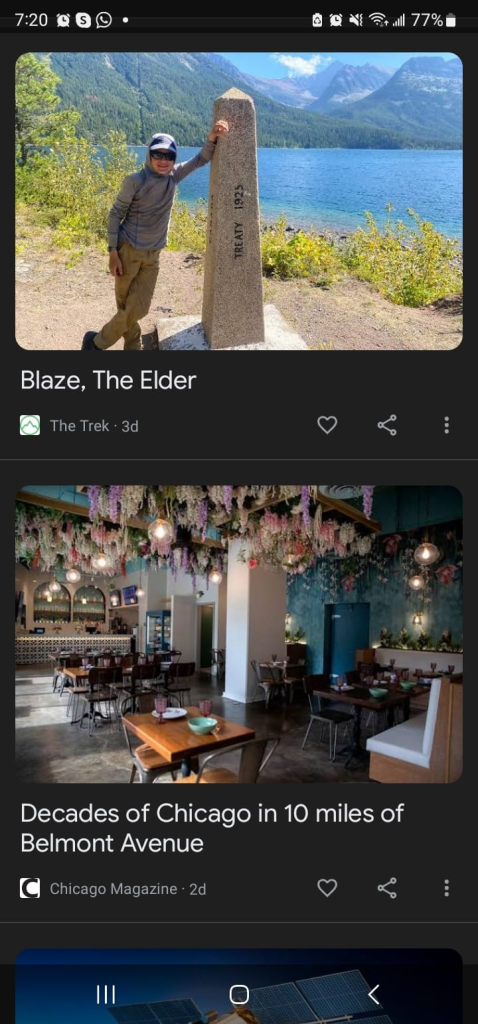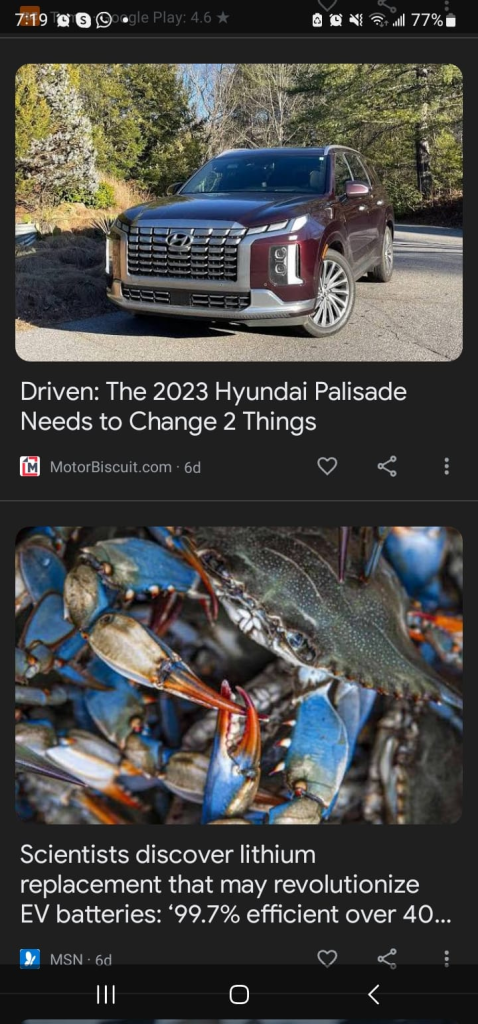Some posts only go to subscribers via email. EXCLUSIVELY.
You can read more here or simply subscribe:
Where to get traffic (other than from Search)
As mentioned in previous posts, I am in the process of pivoting my business model.
Pivoting seems to be a very popular concept these days, judging by my Twitter feed and conversations that I have with fellow publishers.
In our case, it looks like this –
Previous direction: Almost 100% Google traffic from mainly longtail queries.
Current direction: Diversifying traffic sources and adding non-Google sources into the mix again. That means experimenting with new types of content and newish traffic sources.
I had several readers reach out to me following my last emails, asking about the potential traffic sources that we’re pursuing. In other words –
Where can you get traffic that is not from Search? So this is what I want to talk about today.
Why Pivot?
My web publishing business did quite well in 2022. We managed to establish a good rhythm for producing decent content that helped people who were searching Google.
We reached over 1,000 published posts per month thanks to a fantastic team and solid workflows and routines.
But as we scaled, I got worried.
Once a month, our managers join together on a Zoom call. Each manager presents their department’s work over the previous month, and we discuss various company-wide issues.
For my part of the call, I typically give them an update on the state of the industry and what our strategy is.
I just went back to my old slideshows. It was back in June 2022, while our traffic was growing like crazy, that I got worried and started thinking about pivoting.
Here’s a part of one of those June 22 slides –

Note the 2023 timeline.
I didn’t want to pivot too soon because, well, longtail was working VERY well for us. It was too tempting to keep the machine running without taking power away to try new options.
Was that smart? I don’t know.
I do know that a couple of months later, Google started rolling out one update after the other and I could tell that 2023 would look very different.
I already blogged here about the problem with longtail content. It wasn’t just a question of Google updates. And then, in December, generative AI took a major leap forward in the form of ChatGPT, creating even more problems.
Ok, I’m probably rambling now about things that you already know. Sorry, that was not my intention when I started this post.
Let’s try to pivot back to the main idea.
And the main idea for this post is to take you through the process I went through when setting up our 2023 strategy and list the potential sources of traffic we’re now pursuing, in addition to search traffic.
So, where to get more traffic?
Having decided that we will no longer rely solely on Google, the next step was to break down the potential sources of traffic a website could get. Other than search traffic, that is.
Here’s the list I came up with.
Social Media
There are many social media platforms. When it comes to generating traffic, some are better than others.
The key to getting traffic to an informational site (i.e., not an e-commerce site) is to find the right social network for your audience, figure out how to speak their language and get them to follow you, and ultimately, click through to your site.
Social network to consider –
- YouTube (yes, I’m bundling YouTube with the others because I think the principles are similar)
- Tiktok
Are these the only ones? Of course not. But I think they’re the main ones.
These platforms differ from one another in so many ways, including:
- Content format
- How sharable content can be (shared vs. liked/upvoted)
- Audience demographics
- Tools to share your content
- Paid promotion options
All things considered, we decided to focus on Facebook and Pinterest at this point. I’ll explain why later on.
Google News
Yeah, Google again.
When you search for something on Google, you can filter the results down by “news”. This helps if you’re looking for the most current information out there.
You don’t have to be looking for current events, politics, or the weather. Google separates news from other forms of results for any query –

And here’s the thing.
These pages will show up on the main search results too!

Getting into Google news takes some effort. You need to submit your site to Google news, and they will either accept it as a news source or they won’t.
Google Discover
Google Discover is like the holy grail of non-search traffic.
Google Discover is a mobile-only feed that you get on Android phones. If you swipe to the left or just scroll down Chrome’s main screen, you will get a list of recommended articles mixed in with some YouTube videos and Google Web Stories.
That’s Google Discover.
Here are some screenshots from my Discover feed right now –



As you can see, the feed is personalized. Unless you live in Chicago, own a Palisade, are interested in science or hiking, and are worried about snow, your Discover feed probably looks quite different.
You don’t have to submit your site to Google Discover. Google seems to just pick up on some content and try it out there. Then, if the response is good, it can trend there for a while.
There is a LOT of potential traffic in Google Discover.
Many of our sites get Discover traffic on a regular basis (easy to check that in Google’s Search Console), but when a post really trends, the spike can be kinda crazy. We’re talking hundreds of thousands of pageviews within a couple of days. I know, because it’s happened to my sites twice already.
I want more of that.
Unfortunately, no one knows for sure how to optimize for Discover. Google has its guidelines, but they are deliberately vague. I have my own thoughts on how to get more Discover traffic, but it’s too soon to share any of them here.
Moving on to the next traffic source.
Mailing Lists
Did I just say that Google Discover was the holy grail of traffic?
Well, here’s another holy grail: mailing list traffic.
Mailing lists have their pros and cons.
They are expensive to keep and a pain to set up properly. They are also time-consuming to maintain because you have to keep emailing your subscribers.
On the other hand, they offer you a way to capture your visitor’s email and keep them coming to the site. And that can go on forever (or until they are sick and tired of you and hit unsubscribe).
In other words, an email list can be a non-search traffic channel.
And it can help tie together other sources of traffic.
You bring visitors to your site – using search, social media, or any other way – and you convert as many of them into email subscribers. When done right, this can become a source of repeat traffic.
So much for my outline of potential sources of non-search traffic.
What did I miss? Leave me a comment here to let me know.
Moving on to share how I decided which of these methods to employ and why.
First, I needed to decide which sites we were going to focus on. Then, we needed to tailor a specific plan of action for each site, based on our current resources, as well as the niche itself.
What to focus on?
We have a portfolio of more than 20 websites. There was no way we could push forward with them all at once.
And we certainly couldn’t go all in on everything.
I decided to focus on 3-4 sites for now and 2-3 sources of non-search traffic. Here’s why –
Getting traffic from sources other than Google is not very different from creating a “brand”. In both cases, you have to create multiple streams of traffic in a way that helps users identify your site, trust it enough to subscribe to a mailing list, and come back for more.
Creating a brand takes more customization and requires attention. I couldn’t do that for every site in our portfolio. What’s more, not every site is a good candidate for that.
Here are my considerations for choosing the sites and methods to focus on.
Getting the right niche
Some of our sites will forever remain brandless because they don’t have what it takes. They revolve around solving specific problems in a niche:
User has a problem => Googles for the problem => lands on our site and – hopefully – the article helps her solve the problem => User couldn’t care less about returning to the site now that the problem is solved
There is no emotional connection. The products are not ones that people use very frequently. It’s hard to get them to view more content, subscribe, or return to the site (unless they come across another problem.
Probably not impossible to create a trustworthy brand around such a site. But it is so much harder.
Instead, consider niches that involve something people are involved with frequently and are passionate about.
It could be a hobby such as fishing, crocheting, or playing the violin. Or it could be something relating to their everyday life and goals, such as fitness or meditation. Or it could be something that defines them and that’s on their mind on a daily basis, such as parenting or caring for a pet.
So much easier to engage an audience when the topic is one they care about. That narrowed down our choices to 7-8 sites.
Next, I needed to take stock of what resources we had on hand.
Getting the best bang for our buck
Looking for the easiest return on investment, I decided to focus on the platforms with the most traffic: Facebook and YouTube were at the top of the list, followed by Pinterest for the more visual sites.
Youtube was a no-go
Our business was set up to create blog posts. We have in-house writers, editors, and graphic designers.
We don’t have video creators.
What’s more, I have very limited experience with video or with YouTube. Even if I wanted to outsource video creation or hire someone in-house, the learning curve for me would be too steep. I don’t have the time or mental bandwidth to deal with a new front right now.
Social traffic: Focusing on the right networks
Facebook may be for “old people,” but it’s still the largest social network out there.
We focused on two sites that we believed would perform well on Facebook.
Pinterest is sending more traffic these days, so we’re also pushing on that front.
Looking for sites that I thought would do well on Facebook and Pinterest helped me narrow the list down to four websites.
What about Google News?
Setting up a site for Google News is challenging, but we’re headed that way with three of the sites.
We’ve set up news sections on those sites, and we’re producing newsworthy content, trying to find a consistent rhythm that will make Google happy.
I’m also working on setting up better “About Us” pages and creating the kind of sitemaps that Google needs.
At some point, I’ll submit these sites to Google News. However, we’re not in a hurry. I don’t want to rush things.
What about Google Discover?
The kind of content that works on social networks and Google News should also be a good fit for Google Discover.
To help gain more traction, we also publish Google Web Stories on some of the sites. It’s working out well so far. Nothing earth-shattering, but more Discover traffic coming in too.
Topping it all with mailing lists
We have mailing lists set up on most of our sites. With sites that are monetized by Mediavine, it’s easy to collect emails using Grow. You don’t have to be a Mediavine publisher to use Grow, but if you are, it can save you from having to install an additional plug-in.
One of the sites we are focusing on has already collected over 3,000 emails, so we started a weekly newsletter for the niche. We currently have approximately 30% open rates, but our clickthrough rates are only between 1-2%.
About to scrub the list this week for the first time, which should help with increasing those numbers.
That’s all, folks!
I hope you found this post interesting and maybe even helpful. It pretty much sums up where I am right now.
We’re still producing longtail content and still pursuing Google traffic, but at the same time, we’re putting a lot of effort into creating more shareable content and pushing it via the various channels I listed above.
So far, it’s mostly hard work. No major breakthroughs yet. We’ll see when that will happen – if ever.
How about you?
I know many of you are also pivoting away from 100% search traffic.
I’d love to hear more, so drop me a line when you can. Let me know what traffic channels you’re focusing on and how that’s panning out for you so far. Do you have any tips or tricks to share? I’d love to hear them!
And of course, if you have any questions or feedback, send it my way too. I love getting replies to these emails.

I have a question.
Do you remember the article you made that was a high search keyword were you made it super detailed to see if google prefered good quality content or just ok content.
Would be fun to get an update on that. But maybe after the google update =D
Hi Robin,
I don’t even think it was that high search volume, but probably a decent one. My post proudly ranks at #1, right at the top of the cemetery known as Google’s second page of results. It didn’t move during the update, neither down nor up.
Hi Anne,
I am still participating in niche forums and Q&A sites.
When there is a question I have already wrote a blog post about it is worth to share and sometimes it works really well.
Yeah, that’s not a bad idea if you’re already participating in these forums and groups. Participating just to do that would be very time-consuming. If you only show up to post a link, you’re likely to get banned.
Email lists don’t have to be expensive. There are a variety of ways to monetize them. There are quite a few businesses that only focus on list building and they do quite well.
Agreed. And new ways to monetize keep coming up too.